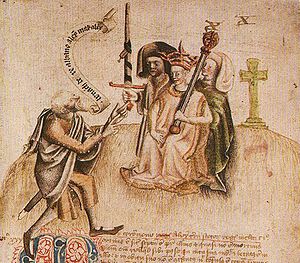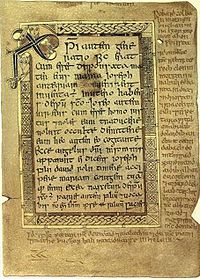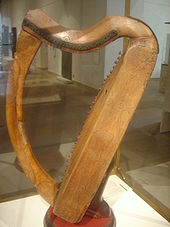
Culture of Scotland in the High Middle Ages
Encyclopedia

Scotland
Scotland is a country that is part of the United Kingdom. Occupying the northern third of the island of Great Britain, it shares a border with England to the south and is bounded by the North Sea to the east, the Atlantic Ocean to the north and west, and the North Channel and Irish Sea to the...
in the High Medieval period
High Middle Ages
The High Middle Ages was the period of European history around the 11th, 12th, and 13th centuries . The High Middle Ages were preceded by the Early Middle Ages and followed by the Late Middle Ages, which by convention end around 1500....
which, for the purposes of this article, refers to the period between the death of Domnall II
Donald II of Scotland
Domnall mac Causantín , anglicised as Donald II was King of the Picts or King of Scotland in the late 9th century. He was the son of Constantine I...
in 900, and the death of Alexander III
Alexander III of Scotland
Alexander III was King of Scots from 1249 to his death.-Life:...
in 1286. The unity of the period is suggested by the immense breaks which occur in Scottish history because of the Wars of Scottish Independence
Wars of Scottish Independence
The Wars of Scottish Independence were a series of military campaigns fought between the independent Kingdom of Scotland and the Kingdom of England in the late 13th and early 14th centuries....
, the Stewart accession and transformations which occur in Scottish society in the fourteenth century and afterwards. The period differentiates itself because of the predominance of Gaelic
Gaels
The Gaels or Goidels are speakers of one of the Goidelic Celtic languages: Irish, Scottish Gaelic, and Manx. Goidelic speech originated in Ireland and subsequently spread to western and northern Scotland and the Isle of Man....
culture, and, later in the medieval, Scoto-Norman
Scoto-Norman
The term Scoto-Norman is used to described people, families, institutions and archaeological artifacts that are partly Scottish and partly Norman...
French culture.
Oral culture
As a predominantly Gaelic society, most Scottish cultural practices throughout this period mirrored closely those of IrelandIreland
Ireland is an island to the northwest of continental Europe. It is the third-largest island in Europe and the twentieth-largest island on Earth...
, or at least those of Ireland with some Pictish borrowings. After David I
David I of Scotland
David I or Dabíd mac Maíl Choluim was a 12th-century ruler who was Prince of the Cumbrians and later King of the Scots...
, the French-speaking kings introduced cultural practices popular in Anglo-Norman England, France and elsewhere. As in all pre-modern societies, storytelling was popular. In the words of D.D.R. Owen, a scholar who specialises in the literature of the era:
Almost all of these stories are lost, or come down only vaguely in Gaelic or Scots
Scots language
Scots is the Germanic language variety spoken in Lowland Scotland and parts of Ulster . It is sometimes called Lowland Scots to distinguish it from Scottish Gaelic, the Celtic language variety spoken in most of the western Highlands and in the Hebrides.Since there are no universally accepted...
oral tradition.
Genealogies
One form of culture extremely well accounted for in this period is genealogyGenealogy
Genealogy is the study of families and the tracing of their lineages and history. Genealogists use oral traditions, historical records, genetic analysis, and other records to obtain information about a family and to demonstrate kinship and pedigrees of its members...
. There are dozens of Scottish genealogies surviving from this era, covering everyone from the Mormaers of Lennox and Moray
Mormaer of Moray
The Mormaerdom or Kingdom of Moray was a lordship in High Medieval Scotland that was destroyed by King David I of Scotland in 1130. It did not have the same territory as the modern local government council area of Moray, which is a much smaller area, around Elgin...
, to the Scottish king himself. In the Poppleton Manuscript
Poppleton manuscript
The Poppleton Manuscript is the name given to the fourteenth century codex likely compiled by Robert of Poppleton, a Carmelite friar who was the Prior of Hulne, near Alnwick. The manuscript contains numerous works, such as a map of the world , and works by Orosius, Geoffrey of Monmouth and Gerald...
, there is a full genealogy of King William I
William I of Scotland
William the Lion , sometimes styled William I, also known by the nickname Garbh, "the Rough", reigned as King of the Scots from 1165 to 1214...
going all the way back to Adam, via Gaidheal Glas. The latter genealogy is just a recording or partial translation of a Gaelic genealogy, where mac ("son") and meic ("sons", or "of the son") have been replaced with filius and filii; moreover, before his grandfather David I, virtually all William's ancestors have their names in the Middle Irish
Middle Irish language
Middle Irish is the name given by historical philologists to the Goidelic language spoken in Ireland, Scotland and the Isle of Man from the 10th to 12th centuries; it is therefore a contemporary of late Old English and early Middle English...
genitive form
Genitive case
In grammar, genitive is the grammatical case that marks a noun as modifying another noun...
(with filii preceding). Furthermore, until at least the reign of Alexander III
Alexander III of Scotland
Alexander III was King of Scots from 1249 to his death.-Life:...
, Scotland's kings maintained an ollamh righe, a royal high poet who had a permanent place in all medieval Gaelic lordships, and whose purpose was to recite genealogies when needed, for occasions such as coronations. The Lord Lyon can be seen as a later development of this role.
Literacy

Loch Leven
Loch Leven is a fresh water loch in Perth and Kinross council area, central Scotland.Roughly triangular, the loch is about 6 km at its longest. The burgh of Kinross lies at its western end. Loch Leven Castle lies on an island a short way offshore...
and Brechin
Brechin
Brechin is a former royal burgh in Angus, Scotland. Traditionally Brechin is often described as a city because of its cathedral and its status as the seat of a pre-Reformation Roman Catholic diocese , but that status has not been officially recognised in the modern era...
into the thirteenth century, it was not the flourishing one that contemporary Ireland possessed, at least not in its written literary output. Latin scribes, even if they knew Gaelic, would normally avoid the Gaelic vernacular and, as elsewhere in Europe, would translate vernacular terms into Latin, so that historians are faced with a Gaelic society clothed in Latin terminology. Even names were translated into more common continental forms; for instance, Gille Brigte became Gilbert, Áed became Hugh, etc.
Literature
There may be more medieval Scottish Gaelic literature than is often thought. Almost all medieval Gaelic literature has survived because it has been allowed to survive in IrelandIreland
Ireland is an island to the northwest of continental Europe. It is the third-largest island in Europe and the twentieth-largest island on Earth...
, not in Scotland. The continentalisation of the Scottish monarchy and Anglicisation of the later medieval Scottish elite meant that Gaelic manuscripts would never be preserved in Scotland. Thomas Owen Clancy has recently all but proven that the Lebor Bretnach, the so-called "Irish Nennius," was written in Scotland, and probably at the monastery in Abernethy. Yet this text survives only from manuscripts preserved in Ireland. In fact, almost all pre-fourteenth century literature than can be attributed to Scotland, survives only from Ireland, England or continental Europe.
There survives a small body of medieval Scottish poetry. There seems to have been some patronage of Gaelic poetry by the later Pictish kings. In the thirteenth century, Muireadhach Albanach
Muireadhach Albanach
Muireadhach Albanach Ó Dálaigh was a Gaelic poet and crusader and member of the Ó Dálaigh bardic family.The Annals of the Four Masters of Ireland, s.a. 1213, tells us that he was the ollamh of Domhnall Ó Domhnaill...
, Irish poet of the O'Dálaigh clan of poets wrote eulogies for the Mormaers of Lennox. He founded the Scottish dynasty of poets known as the MacMuirichs. Muireadhach may have played a large role introducing the new "reformed" style of poetry which had been developing in Ireland in the twelfth century. Muireadhach's friend, Gille Brighde Albanach, was perhaps the most prolifically extant native Scottish poet. About 1218, Gille Brighde wrote a poem - Heading for Damietta - on his experiences of the Fifth Crusade
Fifth Crusade
The Fifth Crusade was an attempt to reacquire Jerusalem and the rest of the Holy Land by first conquering the powerful Ayyubid state in Egypt....
.
In the thirteenth century, French flourished as a literary language
Literary language
A literary language is a register of a language that is used in literary writing. This may also include liturgical writing. The difference between literary and non-literary forms is more marked in some languages than in others...
, and produced the Roman de Fergus
Roman de Fergus
The Roman de Fergus is an Arthurian romance written in Old French probably at the very beginning of the 13th century, by a very well educated author who named himself Guillaume li Clers...
, the earliest piece of non-Celtic vernacular
Vernacular
A vernacular is the native language or native dialect of a specific population, as opposed to a language of wider communication that is not native to the population, such as a national language or lingua franca.- Etymology :The term is not a recent one...
literature to survived from Scotland. Moreover, many other stories in the Arthurian Cycle, written in French
French language
French is a Romance language spoken as a first language in France, the Romandy region in Switzerland, Wallonia and Brussels in Belgium, Monaco, the regions of Quebec and Acadia in Canada, and by various communities elsewhere. Second-language speakers of French are distributed throughout many parts...
and preserved only outside Scotland, are thought by some scholars (D.D.R. Owen for instance) to have been written in Scotland.
Latin too was a literary language. Famous examples would be the Inchcolm Antiphoner, a Lament for Alan, Lord of Galloway
Alan, Lord of Galloway
Alan Fitz Roland was the last of the MacFergus dynasty of quasi-independent Lords of Galloway. He was also hereditary Constable of Scotland.-Family:He was the son of Roland, or Lochlann, Lord of Galloway and Helen de Morville...
and the Carmen de morte Sumerledi ("Song on the Death of Somerled"), a poem which exults triumphantly the victory of the citizens of Glasgow
Glasgow
Glasgow is the largest city in Scotland and third most populous in the United Kingdom. The city is situated on the River Clyde in the country's west central lowlands...
over Somailre mac Gilla Brigte
Somerled
Somerled was a military and political leader of the Scottish Isles in the 12th century who was known in Gaelic as rí Innse Gall . His father was Gillebride...
. Additionally, almost all historical writing from this period was also written in Latin.
There is no extant literature in the English language in this era, although that language would experience a literary take-off in the century after this period. There is a little Norse literature from Scandinavian parts, such as the Northern Isles
Northern Isles
The Northern Isles is a chain of islands off the north coast of mainland Scotland. The climate is cool and temperate and much influenced by the surrounding seas. There are two main island groups: Shetland and Orkney...
and the Western Isles. The famous Orkneyinga Saga
Orkneyinga saga
The Orkneyinga saga is a historical narrative of the history of the Orkney Islands, from their capture by the Norwegian king in the ninth century onwards until about 1200...
however, although it pertains to the Earldom of Orkney
Earldom of Orkney
The Earldom of Orkney was a Norwegian dignity in Scotland which had its origins in the Viking period. The title of Earl of Orkney was passed down the same family line through to the Middle Ages....
, was written in Iceland
Iceland
Iceland , described as the Republic of Iceland, is a Nordic and European island country in the North Atlantic Ocean, on the Mid-Atlantic Ridge. Iceland also refers to the main island of the country, which contains almost all the population and almost all the land area. The country has a population...
. The Western Isles would be integrated into Scotland during this period, but the Northern Isles were ruled from Norway until the late 15th century.
Music

The medieval Scots indeed took harping very seriously. We know that, even half a century after Gerald was writing, King Alexander III kept a royal harpist. Of the three medieval harps that survive, two come from Scotland (Perthshire), and one from Ireland. Singers (i.e. the crowd) also had a royal function. For instance, when the king of Scotland past through the territory of Strathearn, it was the custom that he be greeted by seven female singers, who would sing to him. When Edward I approached the borders of Strathearn in the summer of 1296, he was met by these seven women, "who accompanied the King on the road between Gask
Gask
Gask, gasque, a kind of Swedish student party which starts with a more or less formal dinner. The word is believed to originate from the card game vira, popular in the 19th century....
and Ogilvie
Ogilvie
Ogilvie is a surname with origins in the Barony of Ogilvy in Angus, Scotland. See Clan OgilvyOgilvie may refer to:-People:*Albert Ogilvie , Premier of Tasmania in the 1930s*Alec Ogilvie , pioneer British aviator...
, singing to him, as was the custom in the time of the late Alexander kings of Scots".
Primary
- Gerald of Wales, The History and Topography of Ireland, tr. John O’ Meary, (London, 1982)
- Clancy, Thomas OwenThomas Owen ClancyProfessor Thomas Owen Clancy is an American academic and historian who specializes in the literature of the Celtic Dark Ages, especially that of Scotland. He did his undergraduate work at New York University, and his Ph.D at the University of Edinburgh. He is currently at the University of Glasgow,...
(ed.), The Triumph Tree: Scotland's Earliest Poetry, 550-1350, (Edinburgh, 1998) - Guillaume le Clerc, Fergus of Galloway, tr. D.D.R. Owen, (London, 1991)
- Skene, William F.William Forbes SkeneWilliam Forbes Skene , Scottish historian and antiquary, was the second son of Sir Walter Scott's friend, James Skene , of Rubislaw, near Aberdeen....
(ed.), Chronicles of the Picts and Scots: And Other Memorials of Scottish History, (Edinburgh, 1867)
Secondary
- Bannerman, JohnJohn Bannerman (historian)John Walter MacDonald Bannerman was a Scottish historian, noted for his work on Gaelic Scotland.He was born in Balmaha, Stirlingshire, the son of John MacDonald Bannerman, later Lord Bannerman of Kildonan, and his wife Ray Mundell...
, “The Kings Poet”, in The Scottish Historical Review, V. LXVIII, (1989) - Barrow, G. W. S., Robert Bruce and the Community of the Realm of Scotland, (Edinburgh, 1988)
- Broun, DauvitDauvit BrounDauvit Broun is a Scottish historian, Professor of Scottish History at the University of Glasgow. A specialist in medieval Scottish and Celtic studies, he concentrates primarily on early medieval Scotland, and has written abundantly on the topic of early Scottish king-lists, as well as on...
, The Charters of Gaelic Scotland and Ireland in the Early and Central Middle Ages, Quiggin Pamphlet no.2., (Cambridge. 1995) - Broun, Dauvit, “Gaelic Literacy in Eastern Scotland between 1124 and 1249” in Huw Pryce (ed.), Literacy in Medieval Celtic Societies, (Cambridge, 1998), pp. 183-201.
- Broun, Dauvit, The Irish Identity of the Kingdom of the Scots in the Twelfth and Thirteenth Centuries, (Woodbridge 1999)
- Clancy, Thomas Owen, “Scotland, the ‘Nennian’ recension of the Historia Brittonum, and the Lebor Bretnach”, in Simon Taylor (ed.) Kings, Clerics and Chronicles in Scotland, 500-1297, (Dublin/Portland, 2000), pp. 87-107.
- Dumville, David N.David DumvilleProfessor David Norman Dumville is a British medievalist and Celtic scholar. He was educated at Emmanuel College, Cambridge, Ludwig-Maximilian Universität, Munich, and received his PhD. at the University of Edinburgh in 1976. In 1974, he married Sally Lois Hannay, with whom he had one son...
, "St Cathróe of Metz and the Hagiography of Exoticism," in Irish Hagiography: Saints and Scholars, ed. John Carey et al. (Dublin, 2001), pp. 172-6 - Jackson, Kenneth H.Kenneth H. JacksonKenneth Hurlstone Jackson was an English linguist and a translator who specialised in the Celtic languages. He demonstrated how the text of the Ulster Cycle of tales, written circa AD 1100, preserves an oral tradition originating some six centuries earlier and reflects Celtic Irish society of the...
(ed), The Gaelic Notes in the Book of Deer (The Osborn Bergin Memorial Lecture 1970), (Cambridge (1972) - Neville, Cynthia J., Native Lorship in Medieval Scotland: The Earldoms of Strathearn and Lennox, c. 1140-1365, (Portland/Dublin, 2005)
- Owen, D. D. R., The Reign of William the Lion: Kingship and Culture, 1143-1214, (East Linton, 1997)

